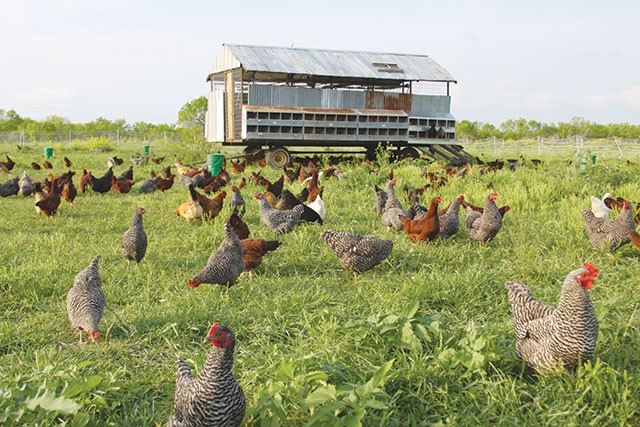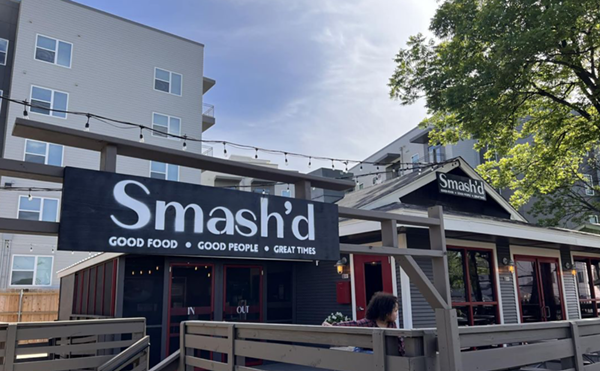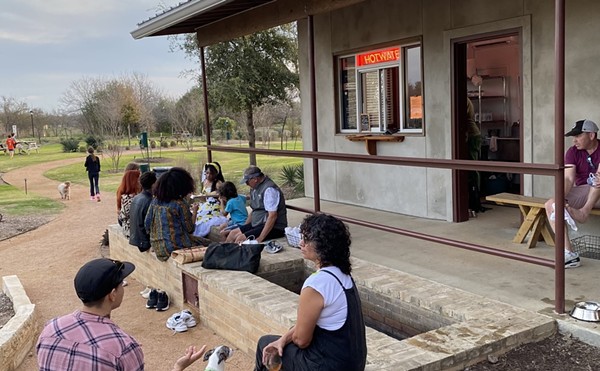[Photos from Parker Creek Ranch]
There’s a certain sense of guilt that comes along with eating mass-produced poultry. There’s only so many blinders we can put on to block out knowledge of where our food comes from.
Gone are the picturesque Old McDonald farms. Instead, most of the poultry we consume comes via factories and assembly lines that treat workers poorly (see the U.S. Department of Labor’s OSHA citation of Tyson Foods as recently as December 17, 2013, after a worker’s hand was severed due to four workplace safety violations), and then, of course, there’s the birds.
If you’ve spared yourself the trauma of Food Inc. since the documentary film’s 2008 release, here’s what we learn in the first 15 minutes: Meat birds are packed inside dark chicken houses or concentrated animal feeding operations (CAFOs for short), hardly ever seeing the light of day. Large numbers of chickens are kept in extremely close quarters usually for about seven weeks where they swiftly plump up on a diet of grains and soy-based feed. These genetically modified birds, bred to gain weight extremely quickly, are often too top-heavy to stay on their feet any length of time. Immobile or not, these chickens breathe in fecal particulate, which requires the use of antibiotics to help stave off health woes such as abscesses and lesions. How nutritious!
No wonder the release of Food Inc., plus several contemporaneous books and exposés in the same vein, has caused the owners of these so-called factory farms to lobby for the passage of “ag gag” laws, which would criminalize photography and videos made on these premises without permission.
There’s a lot that goes into your average chicken breast (or pork chop or skirt steak) that could cause consumers to lose their appetites.
But, even with the veil partially lifted on their unpleasant operations, chicken giants continue not only existing, but making a profit. That should be troubling even for those not phased by factory farm life. As Tyson executives pointed out during a February 27 agricultural conference, shareholders should expect a 10 percent earnings per share increase in 2015 and subsequent years. Turns out Tyson and its peers can strategically manipulate market price for chickens with zero legal ramifications.
If any of this makes you want to swear off the fowl forever, first consider all your options. Enter the “alt-birds,” chickens raised by indie farmers. Within 50 miles of San Antonio, there’s a few such farms, including Floresville’s Peeler Farms and D’Hanis’ Parker Creek Ranch, which buck big ag’s business plan to focus on producing pasture-raised chickens using non-GMO and soy-free feed. Rarely has a hipster trend been so feel-good, or tasty … or expensive.
Breaking (Price) Point
At first glance, Christopher Leonard’s The Meat Racket looks like the latest entry into James Patterson’s psychologist-turned-badass Alex Cross series. A shiny yet murderous meat hook in the foreground, blood red lettering and a subtitle that alludes to secrecy hardly brings to mind a farm. The non-fiction book, released February 18, also reads like a thriller, following the not-so-palatable history of Tyson Foods from its Depression Era roots as a humble Arkansas farm to a cost-cutting pioneer in massive farming operations.
But perhaps the darkest and juiciest “secret” part of Leonard’s book is the description of how current CEO Donnie Smith helped steer Tyson through an economic slump with an intricate way of cutting production, which encouraged raising prices and therefore profits. The timing for this had to be perfect, as Leonard points out. Smith and other top execs used software programs to predict how much meat would be purchased within a 180-day period by big clients (McDonald’s, Walmart). In the case of a projected surplus of fresh meat, which would lead to discounts, the company decided to cut production within the 180-day window. Prices for boneless, skinless chicken breast inevitably went up by 20 cents, according to Leonard.
“It’s not just that Tyson can cut supply, they cut it at strategic moments to manage supply and demand,” Leonard said during a phone interview last week.
Because Tyson and other big chicken companies control every aspect of production, from chick hatcheries to feed mills to slaughterhouses, there’s not a lot the government can do to stop them. Even antitrust legislative efforts during Obama’s first term went awry as lobbyists spent about $8 million to defeat a proposal by the president “which would institute new antitrust measures and curb the power of big meat companies” wrote Leonard in an essay excerpted on Slate. As he pointed out over the phone, the $8 million was solely for lobbying on this specific issue; this doesn’t include campaign contributions by big poultry.
As a former agribusiness reporter for The Associated Press, Leonard also went into the history of industrialized chicken production, how chicken monopolies were torn down through antitrust laws during Teddy Roosevelt’s presidency—which allowed for competition and fair market prices—to the current state of big chicken where three companies (Tyson Foods, Pilgrim’s Pride and Perdue Farms) control half of the chicken market in the U.S.
Grim? Yes. Changeable? Maybe in the long run.
“There has to be tremendous political willpower on behalf of the USDA. Whether it can happen within the last two years of this administration is doubtful … but the blueprint of the antitrust laws are sitting on the shelf at the USDA,” Leonard said, referencing the U.S. Department of Agriculture. “It’s not rocket science, but there’s too much money to be made.”
In The Meat Market, Leonard also clued readers into the lives of Tyson workers and farmers under contract with the company, several of whom have lost their farms trying to compete with other neighboring farms as part of Tyson’s tournament system. In so many words, farmers are pitted against each other in a Hunger Games-type tournament on “how much feed it takes a farmer for his chickens to gain one pound of meat.” Farms deemed less efficient are essentially driven out of business, in the same way poor District 12 tributes would rarely be named victors.
Leonard doesn’t paint a pretty picture, by any means, but there are options in case eating mass-produced, antibiotic-laden and inhumanely raised fowl isn’t your thing.
Bird Yard
A short trek south on U.S. Route 281 will land you at Peeler Farms, with its bright green pastures and hilly landscape that houses the occasional flock o’ ducks or sheep. Driving up, I briefly confused it for a Windows screensaver.
A former physical education teacher, current CrossFit nut and mother of four teens, Marianna Peeler got into the chicken game as a hobby. After moving from El Campo—some 55 miles northeast of Victoria—to Floresville, Peeler purchased 25 laying hens, which produced far too many eggs for a family of six.
In 2007, she took the surplus eggs to her CrossFit gym and sold each dozen for $2. Her organic eggs fit right in with the clean food diet—“ garden vegetables, especially greens, lean meats, nuts and seeds, little starch and no sugar—espoused by CrossFitters. Once her fit brethren realized she was a farmer, they started asking for chicken and other poultry products.
Peeler Farms’ initial foray into poultry began with turkeys for Thanksgiving and, as Peeler put it, “we moved onto the meat birds and it’s never stopped since.”
Because her husband, Jason, is a cattle rancher, Peeler already had land (some 2,000 acres) and infrastructure to start her project with relative ease. “We had the facilities but it was just about outfitting them for our use,” she said.
The main barn holds several pens, originally made of wood and wire but currently being refurbished with plastic to help stave off diseases and pests that can live in the wood. Each ample pen holds chicks of a different age range along with a heat source, clean water and feed processed in Poth, just southeast of Flooresville. Chicks are kept in spacious pens from the time they’re one week old to just about four weeks. Once they’re old enough to survive in the pasture, usually at the four-week mark, they’re transferred outdoors. The ranch adds 200 to 225 chicks a week and 450 every two weeks.
The meat birds, or broilers, spend about four to six weeks in the pasture. The exact timing depends on the weather, which can come into effect during the harsh winter months and scorching summer days. To alleviate the heat, Peeler chicken shelters are equipped with timed sprinklers.
Once the birds reach eight to 10 weeks, they’re processed inside a newly added plant. In the past, processing meant a five-hour drive to a Dallas-area farm where the chickens would be slaughtered and packaged, but costs started piling up and the chickens’ welfare became an issue as every drive meant the birds would excrete a stress hormone that inevitably changed the flavor of the meat. The Peeler plant is made up of three 20-by-16-foot processing rooms, each of which is infinitely cleaner than any desk I’ve ever occupied.
Peeler, farmhand Melissa Barfield and four workers take on the process of killing, scalding, plucking, inspecting and packaging 150 to 200 birds on Tuesdays. First, the chickens are placed in funnel-like metal cones, which help keep them from flapping and bruising themselves. The workers take a surgical scalpel to the bird’s carotid artery and the birds pass out within 10 to 15 seconds.
“I’ve had people say, ‘How can you kill chickens?’ My thinking is, somebody’s gotta do it, and at least I know it’s done right. No, I don’t like it and it’s kind of gross, but I do know that it’s done very well and it’s clean,” Peeler said. Whereas each chicken is processed individually in the metal cones, big ag chickens are dipped into electrified water from their ankles and then bled to death after having their throats slit.
Peeler delivers fresh birds on Wednesdays to Austin eateries including the upscale Jeffrey’s, a community supported agriculture (CSA) program and three CrossFit gyms.
Delivery to San Antonio restaurants runs throughout the week to Restaurant Gwendolyn (Peeler’s first client), Lüke San Antonio Riverwalk, Cured and Uncommon Fare, which both sells the meat and uses the birds in their prepared foods. Birds not delivered to these restaurants are vacuum-packed for Saturday’s Pearl Farmers Market where Peeler and two of her kids sell whole chickens at $4 a pound.
“I go to Whole Foods and look at their prices and stay either at that same mark or slightly under if I can,” Peeler said.
“It doesn’t escape me when I’m at the market that I’m a higher-end vendor—all the meats at the [farmer’s market] are. You have to be aware of that,” Peeler noted. She tries to facilitate the process for market-goers on a budget by offering leg quarters and other economical cuts such as drumsticks. “I try to find something so everyone can afford to eat well,” Peeler said.
Money Talks
Even during a late February visit, there’s plenty of scenic views of Parker Creek Ranch’s laying hen coop on the south border, colorful blooming garden and nocturnal Great Pyrenese mix farm dogs that laze about during off-duty hours. Parker Creek Ranch proprietors, Mandy and Travis Krause, are almost as bucolic.
Both 27 years old, the Krauses have been at this for some four years, first as chicken farmers exclusively, though now they’re experimenting with grass-fed beef and rabbits. The couple met at Texas A&M University while they both worked toward bachelor degrees in wildlife and fishery sciences.
Travis went on to work in India and South America while Mandy worked as a field technician in Texas and Montana. But a life-changing read drove Travis back home to reinvigorate his family’s 500-acre ranch.
“You’re not really encouraged to come back to the ranch … You’re supposed to go off and become a lawyer, a doctor or an accountant because this isn’t the most profitable business for the amount of work you’re putting into it,” Travis said.
After reading Joel Salatin’s Pastured Poultry Profits, Travis decided to give chicken farming a go. Salatin is best known as a sustainable agriculture leader who pioneered alternative farming in the ’80s at his Polyface Farm, and has been featured in Michael Pollan’s Omnivore’s Dilemma as well as Food, Inc. He preaches transparency in farms, pastured livestock and poultry, individuality for animals, community building and the use of earthworms. His book describes ways for entrepreneurs to give farming a shot.
He may make it sound doable, but unlike Salatin, the Krauses have to deal with an ever-present drought and being a two-person operation. “Salatin’s got an army of interns, we don’t,” Travis said.
With the help of “wwoof-ers,” or volunteers through World Wide Opportunities in Organic Farms, an organization that links willing workers with organic farms, Travis built eight covered shelters that held 100 birds each. Early on, Travis and the wwoof-ers would hook the shelters up to an ATV and move it a few feet in a different direction every day.
The farm now uses a new model the Krauses call a Portable Chicken Shelter, or PCS. The triangular shelters are rigged up on wheels so the birds can come and go as they please within a 5,445 square-foot, open-air perimeter. While pasture-raised, even chickens need boundaries—and protection.
One of the farm dogs stays inside the enclosure to ward off predators, such as hawks, owls, coyotes, raccoons and skunks. (Fun note: Peeler described skunks as the Charles Manson of the predator world because they decapitate the body and leave the carcass intact.)
The Krauses only raise meat chickens from April through November due to the harsh extremes of both winter and summer in South Texas. They currently raise 150 meat chickens a week, an economical Cornish Cross and a Naked Neck chicken, which they deemed more sustainable and well-rounded.
“They’re healthier, they’ll fly, they’re a truly functional chicken,” Mandy said. “They don’t get leg problems or diseases.” Naked Neck birds are also better foragers, and take just about the same amount of feed to raise, except they’re raised for 12 to 14 weeks as opposed to about eight weeks for the Cornish Cross. In other words, these sustainable chickens don’t plump up as fast as their CAFO-raised cousins, which are usually slaughtered at seven weeks old.
This translates to a higher cost at the Pearl Farmers Market on Saturdays and the Quarry Farmers and Ranchers Market on Sundays: Cornish Cross usually go for $4.25 a pound versus the $5 a pound for a Naked Neck. The birds also look different: The Cornish has larger breasts, while the Naked Neck is a slimmer and leaner bird with more dark meat.
“Americans love big chicken breasts,” Travis lamented; “The reality is, if you want to feed a chicken good feed, raise them right, it’s going to cost money to do that. Our profit margins aren’t huge, people gawk at the prices but we’re eking out a living. We don’t pay ourselves a salary.”
For these ranchers, the ultimate goal is education.
“What we’ve learned through the years is that to save wildlife, to save agriculture, it’s not about research and how one plant affects another,” Travis said. “It’s about educating people to care about things, to show them how it’s all connected and that we need to take better care of the world.
Concentrated animal feeding operations [are] not the way to do it.”
They routinely host groups of Future Farmers of America from area high schools and give tours of their set-up, which includes the nitty-gritty bits like using nitrate-rich straw beds for their garden and to reenergize bare patches in the landscape.
“When we see a bare spot, it’s like, ‘Oh, God, do we have to rotate the chickens more often? Do we have to reseed? Do we need to add amendments to the soil as far as organic matter?’” Travis said. “The chickens are a land-management tool.”
Again, their time at Texas A&M comes in handy as they run vegetation surveys on the land and try implementing other systems to revitalize the 600-acre ranch. Unfortunately, much like other area ranchers, their biggest obstacle is the drought and how to deal with it using only a small amount of capital.
Even laying out irrigation pipeline could mean a $30,000 dollar investment. A small processing plant set them back initially, but transporting the birds to another farm wasn’t an option.
So what?
No, boutique farming ain’t easy. The Krauses have even struggled to keep a permanent non-GMO feed supply, which, by the way, accounts for most of their expenses. The drought isn’t predicted to let up and the drive to the market isn’t going to get any shorter, but they’ll do it because both Peeler and Krause can’t get behind CAFOs or even slightly larger operations than their own farms.
“I tried raising more, doing more and I felt like either the quality of the bird or their quality of life would suffer … the kids or me, would suffer,” Peeler said. “I couldn’t see that it was worth it.”
The spread of these boutique farms gives Leonard some hope. As a husband and father of three, and a journalist (not a field known for fat paychecks), Leonard supplements his grocery store meat supply with locally raised poultry through a CSA.
“My point is not that consumers need to go vegetarian or quit eating meat,” Leonard said. His point is to encourage competition by implementing antitrust laws, which he argues are good for farmers and good for consumers. Competition helps lower prices, introduce higher quality of products, promote innovation for farmers and gives them more leverage when it comes to selling their product rather than going into a contract with big poultry.
Is Leonard nostalgic for the picturesque farms as Washington Post critic Bethany McLean suggests? No. “For decades we had a beautiful entrepreneurial and transparent meat system that was the source of prosperity and it was great … now four companies have taken over to the detriment of farmers and consumers,” Leonard said.
Much like Leonard, I can’t always afford these alt-birds. After preparing a rather large-breasted roasted chicken this past weekend, a bit of self-disgust ran through me. Sure, I’ve consumed Peeler birds at Gwendolyn, Luke, Cured and The Monterey, and Parker Creek birds at The Granary, but there I was, exacerbating the problem at home. My beautiful bird with its crispy, golden brown skin was tainted.
“When people come to me at the market, they’re sacrificing something else. It’s still a luxury item,” Peeler said. “Not everyone can afford to spend $16 for a chicken.”
But along with the higher price and healthier bird comes something else—peace of mind.


















